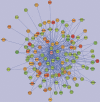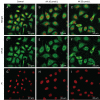Microarray analysis reveals the inhibition of nuclear factor-kappa B signaling by aristolochic acid in normal human kidney (HK-2) cells
- PMID: 20139906
- PMCID: PMC4002842
- DOI: 10.1038/aps.2009.197
Microarray analysis reveals the inhibition of nuclear factor-kappa B signaling by aristolochic acid in normal human kidney (HK-2) cells
Abstract
Aim: To study the molecular mechanism underlying the effect of aristolochic acid (AA), a major active component of plants from the Aristolochiaceae family using microarray analysis.
Methods: Human kidney (HK-2) cells were treated with AA (0, 10, 30, and 90 micromol/L) for 24 h, and the cell viability was measured by a 3-(4,5-dimethylthiazol-2yl)-2,5-diphenyltetrazolium bromide assay. Complementary DNA microarrays were used to investigate the gene expression pattern of HK-2 cells exposed to AA in triplicate. A quantitative reverse transcriptase-polymerase chain reaction (qRT-PCR) assay was used to verify the microarray data for selected nuclear factor kappa B (NF-kappaB)-regulated genes. Furthermore, the subcellular localization of NF-kappaB p65 was visualized by immunofluorescence confocal microscopy in HK-2 cells. The NF-kappaB activity was examined by a luciferase reporter assay in HK-2/NF-kappaB transgenic cells.
Results: AA exhibited a dose-dependent cytotoxic effect in HK-2 cells and induced alterations in the gene expression profiles related to the DNA damage response, DNA repair, macromolecule metabolic process, carbohydrate metabolic process, DNA metabolic process, apoptosis, cell cycle, and transcription. In addition, 9 biological pathways associated with immunomodulatory functions were down-regulated in AA-treated HK-2 cells. A network analysis revealed that NF-kappaB played a central role in the network topology. Among NF-kappaB-regulated genes, 8 differentially expressed genes were verified by qRT-PCR. The inhibition of NF-kappaB activity by AA was further confirmed by immunofluorescence confocal microscopy and by NF-kappaB luciferase reporter assay.
Conclusion: Our data revealed that AA could suppress NF-kappaB activity in normal human cells, perhaps partially accounting for the reported anti-inflammatory effects of some plants from the genus Aristolochia.
Figures




References
-
- Rosenmund H, Reichstein T. Zur Kenntnis der Aristolochiasäure. Pharm Acta Helv. 1943;18:243–61.
-
- Debelle FD, Vanherweghem JL, Nortier JL. Aristolochic acid nephropathy: a worldwide problem. Kidney Int. 2008;74:158–69. - PubMed
-
- Zhang G, Shimokawa S, Mochizuki M, Kumamoto T, Nakanishi W, Watanabe T, et al. Chemical constituents of Aristolochia constricta: antispasmodic effects of its constituents in guinea-pig ileum and isolation of a diterpeno-lignan hybrid. J Nat Prod. 2008;71:1167–72. - PubMed
-
- Messiano GB, Vieira L, Machado MB, Lopes LM, de Bortoli SA, Zukerman-Schpector J. Evaluation of insecticidal activity of diterpenes and lignans from Aristolochia malmeana against Anticarsia gemmatalis. J Agric Food Chem. 2008;56:2655–9. - PubMed
-
- Hinou J, Demetzos C, Harvala C, Roussakis C. Cytotoxic and antimicrobial principles from the roots of Aristolochia longa. Int J Crude Drug Res. 1990;28:149–51.
Publication types
MeSH terms
Substances
LinkOut - more resources
Full Text Sources
Molecular Biology Databases

